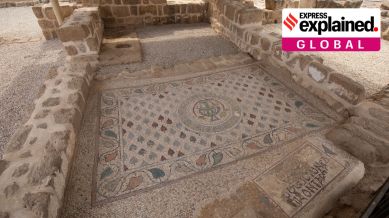Why inclusion of Gaza’s Tell Umm Amer in the World Heritage Site List matters
Also known as the Monastery of Saint Hilarion, the site can be dated back to the fourth century CE. It has been damaged during the ongoing conflict in Gaza.

The World Heritage Committee (WHC) on Friday decided to include the Palestinian site of Tell Umm Amer in both the UNESCO World Heritage Site List and the Lost of World Heritage in Danger during its 46th session in New Delhi.
Also known as the ‘Monastery of Saint Hilarion’, the site lies in the Gaza Strip which continues to reel under Israel’s relentless assault. Here is the historical significance of Tell Umm Amer, and what the World Heritage inclusions might mean for it.
Fourth century monastery
Situated on the coastal dunes of the Nuseirat Municipality, just 10 km south of Gaza city, the ancient Christian monastery was founded in the fourth century by Hilarion the Great (291-371 CE), considered by some to be the father of Palestinian monasticism.
Born in Tabatha, close to where his monastery would eventually come up, Hilarion became a monk at the age of 15. As his fame grew, and people began coming to him for miracles, his small hermitage went on to become a thriving monastery, which attracted followers from all over, many of whom would choose Hilarion’s mendicant lifestyle.
The present-day archaeological remains of the site span more than four centuries, from the time of Hilarion to the Umayyad period. The ruins comprise “five successive churches, bath and sanctuary complexes, geometric mosaics, and an expansive crypt” making the monastery “one of the largest in the Middle East”, according to The World Monuments Fund, an independent organisation which facilitates the preservation of “the world’s most treasured places”. The UNICEF listing of the site refers to Tell Umm Amer as “the first monastic community in the Holy Land”, and “a hub of religious, cultural, and economic interchange”.
The monastery was likely abandoned after a seventh century earthquake, only to be uncovered by local archaeologists in 1999.
Much-needed protection
With Israel’s ongoing onslaught reducing much of the Gaza strip to rubble, monuments and sites of cultural significance have not been spared either.
This is why Tell Umm Amer’s inclusion in the aforementioned UNESCO lists matters. The World Heritage Convention of 1972, of which Israel is a party to, sets out duties for identifying, protecting, and preserving World Heritage sites. Crucially, states cannot take any deliberate measures which are likely to cause direct or indirect damage to this site.
In December 2023, UNESCO’s Intergovernmental Committee for the Protection of Cultural Property in the Event of Armed Conflict had already decided to grant ‘provisional enhanced protection’ to the monastery under the 1954 Hague Convention and its Second Protocol.
The inclusion on the list of World Heritage in Danger automatically opens the door to enhanced international technical and financial assistance mechanisms to guarantee the protection of the property and, if necessary, to help facilitate its rehabilitation, the UNESCO statement on Friday said.